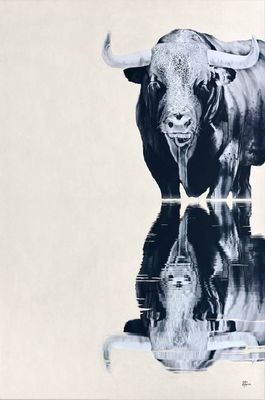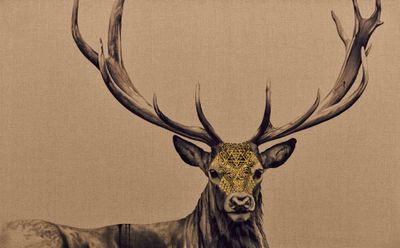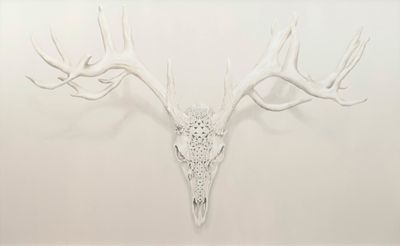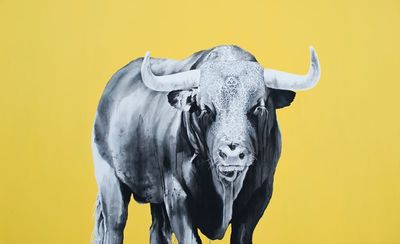
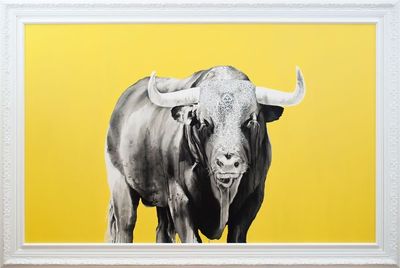
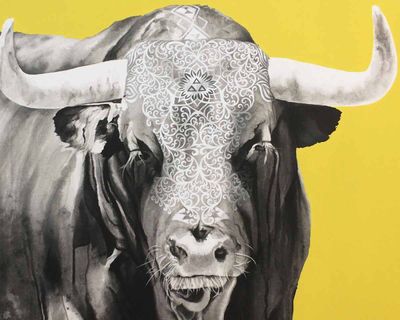
Brahman
$950.00
Explore the story of the artwork >>
Print sizes and editions
- Regular museum archival paper print - 497 x 805mm
(limited to 95) - Large museum archival paper print - 712 x 1153mm
(limited to 95) - Extra Large museum canvas print - 840 x 1361mm
(limited to 95)
Your unique limited edition fine art print
- Sofia Minson creates your exclusive signed print
- We ship for $25 in NZ and from $50 internationally
- Your artwork arrives rolled, ready to be framed - do you need help? Request framing guidance
Original painting SOLD, flashe (acrylic vinyl) on canvas, 1260 x 1885mm including frame, 2017
The story of Brahman
On a recent trip to the South Island to cycle the Otago Rail Trail, we were having a beer outside a tiny little pub in Oturehua. Breaking the stillness of the afternoon, dozens of Hereford beef cattle were suddenly being herded down the main road towards us. The salt-of-the-earth farmer from his ute yelled at us to get behind the table because -theyre not fucking dairy cows."
It was a golden moment. So hilarious. Only in New Zealand. I knew as soon as I got back to my studio I would glory in painting my first ever bovine.
"Brahman" is part of Sofia Minson's 2017 Sacred Mirrors series of works.
Brahman is the name of a variety of cattle in India, but this painting is modelled off an Angus bull. I'm using the word Brahman here in the Hindu sense of the supreme spirit. Brahman has many forms and pervades the whole universe. It is symbolised by the sacred syllable Om, which is the sound or frequency of this dimension. Brahman is present in every person as the eternal atman.
We sense this atman or awareness in ourselves when were totally present. We can experiment getting in touch with the atman by becoming -the watcher." Instead of identifying ourselves with every random thought and emotion, we can try observing the thoughts and feelings in the body as weather or clouds passing by. Treat them with compassion as you would a child who you love. We can choose to not latch onto those phenomena and attach our go-to stories and reasons for things. Sometimes we can just be. And that is what this painting means to me.
In this work, I think of the black paint that washes over the cows body as representing the darkness of chaos. It is night. The womb of potentiality, nature and the source of all creativity. The bright yellow background is the sun. It is the light of day, order, safety and culture. Together they balance yin and yang.
I spent three years living in Sri Lanka with my mum and dad in my early teenage years. This was my introduction to Buddhist and Hindu religions and the idea of the cow as sacred.
Coming from little old New Zealand, I was exposed to drastically different cultures, religions and ways of life. This rapidly transformed my view of the world. It is a mostly Buddhist and Hindu country with a small minority of Muslims and Christians. The holy temples and carvings, both new and thousands of years old, were of great power and artistic beauty.
Cows are deeply revered in Sri Lanka and India due to sacred teachings. Also because they are relied on heavily for dairy products and tilling the fields. Cow dung is a source of fuel, fertilizer and is also the best place to find Psilocybin mushrooms growing in the wild.
When ingested, these mushrooms produce ego dissolving states of consciousness. Truths about the nature of the universe are revealed. Along with meditation, these psychedelic experiences may have seeded many ancient religions. To this day when people of Hindu faith go into a temple, a sacred part of their ritual is to take a handful of white powder and rub it onto their foreheads. That white powder is cremated cow dung.
As a result of this respect, cows cannot be harmed and are allowed to wander freely. Theres obviously a positive and negative side to animals roaming the city streets. Unfortunately in Sri Lanka it was a regular sight to see them munching on piles of rubbish including plastic bags.
The patterns on this cows head are a mixture of Māori and Eastern designs. The eight petalled lotus flower at the centre of the forehead is seen in Buddhist mandalas. It signals cosmic harmony and is often used as an object of focus to aid meditation. The lotus flower closes its petals at night and sinks underwater, to rise and open the petals again at dawn. Ancient Egyptians taught that the lotus represented the sun. Because of this opening and closing cycle, it also symbolised creation and rebirth.
The eight petals of the white lotus seen here, correspond to the Buddhist Noble Eightfold Path. Vision; loving compassion; truthful speech; ethical action; livelihood of non-exploitation; vitality; mindfulness; single-pointedness of mind and body.
The triangular pattern at the third eye is the jewelled doorway into the universal cosmic mind.
Sofia Minson Paintings | New Zealand Artwork
